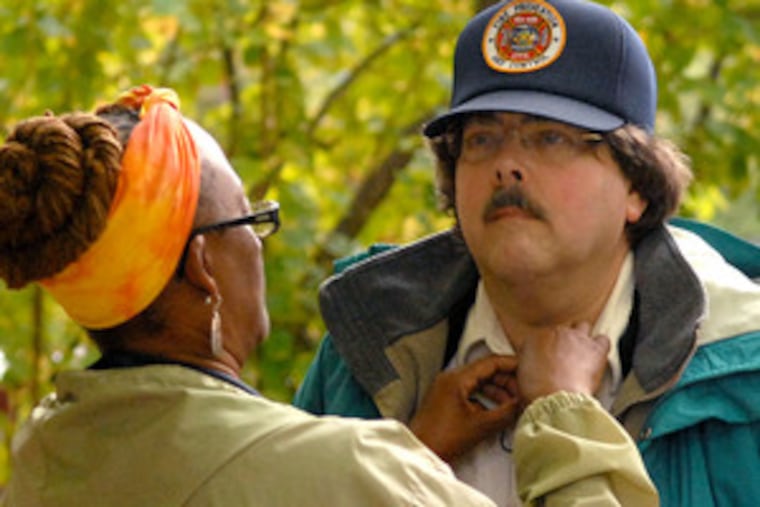
Neighborhoods are places where people live, but some neighborhoods are also places that live on in people's hearts long after they've moved on to someplace else. Greenbelt Knoll is that kind of neighborhood.
Occupying a single dead-end street near Roosevelt Boulevard in the Pennypack Woods section of Philadelphia, Greenbelt Knoll looks like a Poconos summer camp that someone accidentally misplaced in the Northeast. With their redwood walls and flat roofs, the little houses could easily be mistaken for country cabins. A canopy of towering oaks and tulip poplars shelter them from the surrounding hubbub.
But not only is Greenbelt Knoll a full-fledged part of the city, it is also a proud, historic part. It's famous for being the first purpose-built, integrated housing development in Philadelphia, and has been home to such luminaries as the Rev. Leon Sullivan, playwright Charles Fuller, and U.S. Rep. Robert N.C. Nix Sr.
And yesterday the '50s-era oasis of 18 houses got to play a starring role in its own film.
Greenbelt Knoll is one of 10 neighborhoods in Philadelphia and Camden that were documented yesterday during a marathon session by the Scribe Video Center for its Precious Places series, which will be shown eventually on WHYY TV12. The series, in its fourth year, teams skilled videographers with residents to create portraits of the varied places people call home.
In the case of Greenbelt Knoll, that required crews armed with video cameras and mikes to troop down a steep wooded ravine in a steady rain.
Gene Milgram, a former resident who now lives in Annapolis, Md., wanted to make sure the crew got a shot of the community swimming pool alongside Pennypack Creek, where neighborhood kids, both black and white, cavorted during so many long, hot summers.
Never mind that the pool is no longer operational. Michael Hazard, who moved to the neighborhood as a 2-year-old in 1957, cited it as "one of the things here that made me the person I am" because it made him interact with people of different races and cultures. So the camera crews trained their lenses on the pool's crumbling remains, before moving on to other memory-laden spots.
Milgram and Hazard left Greenbelt Knoll behind when they went off to college in the '60s. Yet the neighborhood remains an important emotional touchstone for them.
When they heard about the documentary, both immediately knew they wanted to be included.
Hazard flew in from St. Paul, Minn., while his father, Patrick, traveled from Germany, where he now lives.
For Milgram, it's more than just nostalgia.
Greenbelt Knoll was the brainchild of his father, Morris, an idealist and a socialist who decided in 1955 that the only way to heal America's racial divide was to have whites and blacks live side by side. Since most developers wouldn't sell a new single-family home to a black person, Milgram decided to become a developer himself.
He bought a strip of woodland off Holme Avenue for $2,500, and carved out a subdivision of California-style modernist houses, instructing the builders to treat the 80-foot-tall trees "like people."
Morris Milgram advertised in progressive magazines, such as the Nation, to attract buyers. By 1957, eleven white families and eight black families had moved into the compact three-bedroom houses.
The little one-street neighborhood, on a cul-de-sac called Longford Street, is just as bucolic today as it was half a century ago, perhaps even more so since the trees are taller.
When a falling tree destroyed one of the original 19 houses, neighbors cleared the debris and turned the site into a community park, recalled David Fuller, the son of Pulitzer Prize-winning playwright Charles Fuller, who wrote A Soldier's Play.
The architecture of the houses is considered as significant as the social goals that produced the neighborhood.
They are believed to have been designed by the great Philadelphia architect Louis I. Kahn while he was moonlighting for the firm Montgomery & Bishop.
The noted landscape architect Margaret Duncan laid out the structures so they would melt into the landscape.
Like Milgram and Hazard, David Fuller also moved away to attend college. But after his widowed father bought a condo downtown, he was drawn back. He lives in his childhood home with his wife and two young daughters. He loves coming home to the wooded retreat after a long day as a counselor at Philadelphia's Youth Study Center.
"It's like being wiped clean," Fuller explained. "I always told my mom I would come back and live on this block. It's like a postcard when the snow lays on the trees."
His daughters are discovering the same forest nooks and crannies where he played.
They watch deer browse from their large picture window.
"And last night, I saw a racoon," Fuller said.
His only concern is that the Scribe videographers are able to see the neighborhood the way he does.